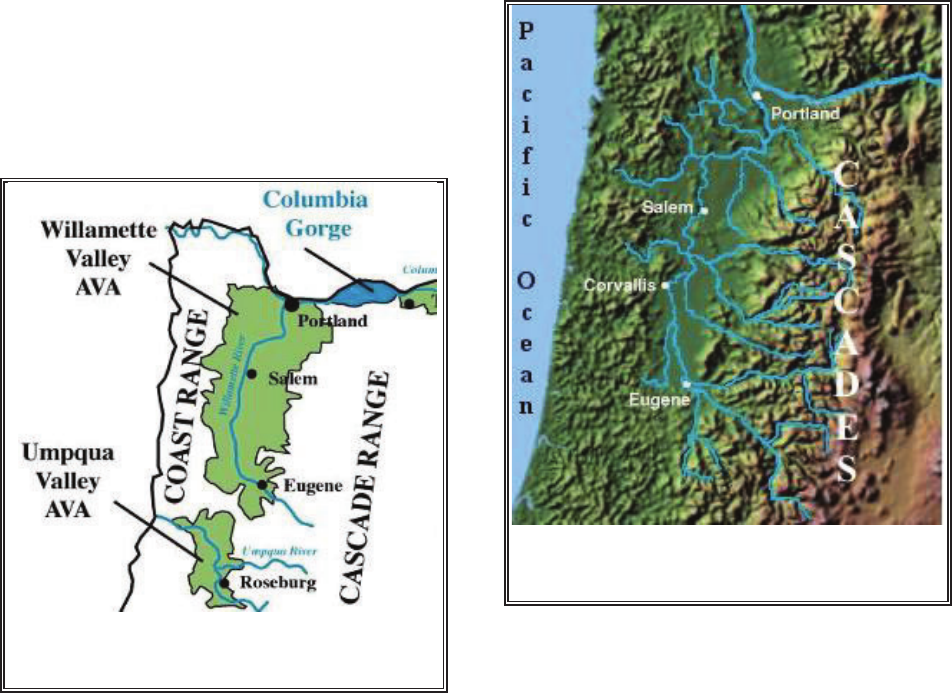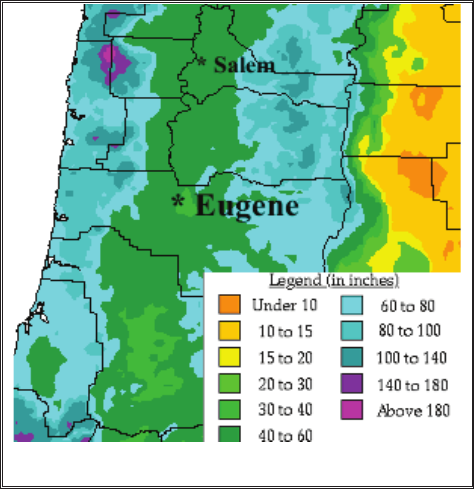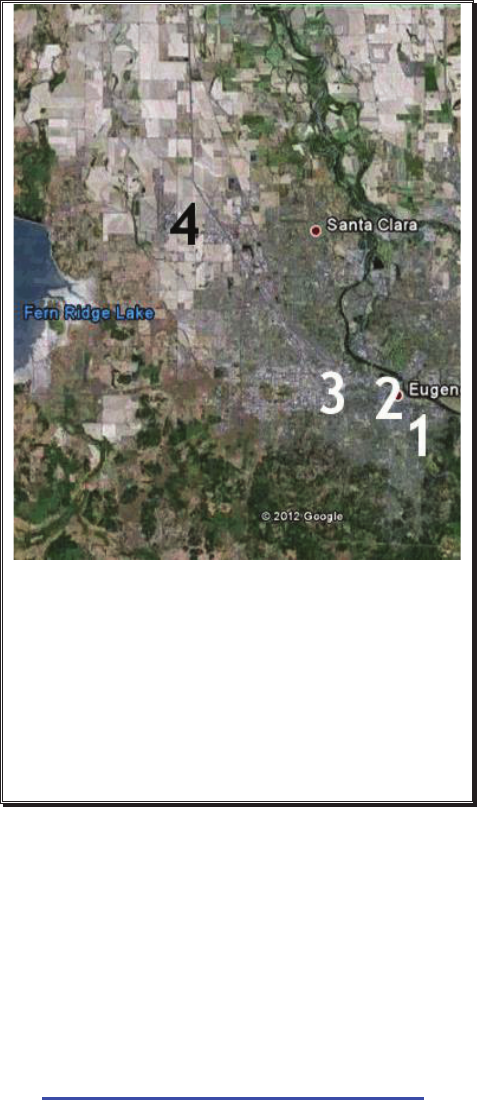
TFDMDKHL@SDTLL@QX
1
Climate of Eugene
I. Geographical Overview.
Eugene is located at the upper end, or southern
end, of the fertile Willamette River Valley.
Mahlon Sweet Field, Eugene’s airport, is the
current location of the weather observation
equipment. The airport is located roughly nine
miles northwest of Eugene’s city center.
Bounding the Willamette River Valley are the
Cascades Range to the east and the Coast Range
to the southwest and west, with low hills to the
south. The Willamette River leaves the
mountainous terrain at Eugene/Springfield area,
and turns north. The Willamette Valley opens
and broadens rapidly to the north of Eugene
(figures 1 and 2).
Figure 1: Willamette Valley and Eugene,
showing geographical features of western
Oregon.
The rolling wooded Coast Range begins ten miles
west of Eugene, and rises from 1500 to 2500 feet
above sea level. Fifty miles to the west, the Coast
Range ends at the Pacific Ocean. To the east and
northeast of Eugene lie the Coburg Hills, rising to
2500 feet above sea level. These are the
beginning of the foothills of the Cascades. For the
next 60 miles to the east lie the volcanic Cascade
Range, with mountain passes near 5500 feet, but
with individual volcanic peaks rising over 10,000
feet in elevation. Small valleys extend from the
Willamette Valley into both the Coast Range and
the Cascades. Abundant precipitation and
moderate temperatures result in rapid growth of
conifer trees, making lumbering and paper
production a major industry. Much of the virgin
timber has been harvested, but with rapid new
growth of trees there is little bare ground in the
mountains.
Figure 2: Willamette Valley and Eugene,
showing topographic features of western
Oregon.
II. Climatological Summary.
The Coast Range provides the Eugene area, with
limited shielding from incoming storms from the
Pacific Ocean. The Cascades offer a steep slope
for orographic lift of moisture-laden westerly
winds, resulting in moderate rainfall for the
region. The Cascades also act as a barrier,
preventing the colder continental air masses that
originate in the arctic areas of Canada, from
invading western Oregon. Occasionally, cold air
does work its way into western Oregon via the
Columbia River Gorge, filling the Willamette
Valley.

2
Rain is a part of life during autumn and winter.
Nearly 90 percent of the annual rainfall occurs
between early October and mid-May. In fact,
only about 2 percent of our rain occurs in July and
August. It is not uncommon to see relatively dry,
with no rain in both July and August. The first
autumn rain often arrives about mid-September,
but it generally is not until early October for the
rain to increase in frequency. Rainfall varies
significantly across the south Willamette Valley
region. The Coast and the Cascade Ranges
receive over 90 inches of rain per year, while the
hills around the Eugene/Springfield area receive
50 to 70 inches. In the heart of the south
Willamette Valley, where the Eugene airport is
located, only about 40 to 50 inches falls annually
(figure 3).
Precipitation falls mostly as rain, with an average
of only four days per year recording measurable
snow. Snow accumulations are rarely more than
two inches, and often melt within a day. Most
likely areas of snow will be the higher terrain
above 900 feet (which includes the South Hills,
and the Coburg Hills. Too many times, warm air
pushing in from the Pacific quickly ends the
threat of low elevation snow. However,
occasionally, significant snow can occur, such as
in January of 1969 when nearly four feet of snow
fell.
The winter season is characterized by mild
temperatures, frequent cloudy skies, and rain.
Winds are predominately either southerly during
the mild rainy spells, or northerly during the
colder dry spells. Outbreaks of cold arctic air
from east of the Cascades will occasionally spill
into Western Oregon via the Columbia River
Gorge, bringing chilly north winds. During these
cold air events, if a moist Pacific front pushes into
the region, rain will occur. Initially, the warm
south winds will not be strong enough to scour
out the cold air from the lowlands. As a result,
the rain falls into the shallow layer of sub-
freezing air, with freezing rain, sleet, and
sometimes snow resulting. Often this phase is of
short duration, with temperatures warming and
ending the threat of freezing/frozen precipitation.
Temperatures are generally mild during the cool
season, with highs in the middle 40s to lower 50s
and lows in the 30s. It is common to see
overnight winter low temperatures into 20s.
During cold nights in winter, with an arctic air
mass in place over the region, winds are often
light under clear skies. This allows for rapid
temperatures falls once the sun sets. At that time,
temperatures can plummet below 20°F. Such
cold temperatures are rare, averaging about twice
per winter. The most notable cold snaps occurred
in 1950 and 1972. During the 1972 cold snap,
Eugene recorded its lowest temperature at 12°F
below zero.
Spring is a transitional time as the weather pattern
shift from winter to summer. However, spring is
not all that warm, and often, not all that dry.
March and April are often damp and cool, with
only a few warm dry days. May and June turn
more dry, and see the most of the warming
weather. Generally, afternoon temperatures
warm from the 60s/70s in May to the 70s/lower
80s in June. However, it is not uncommon to see
temperatures into the 80s in April and May, with
temperatures of 90°F or warmer in May. The
warmest day in May was 95°F, occurring in 2008.
Even though the number of rainy days decreases
in May and June, there are still plenty of cloudy
days, keeping daytime temperatures in the 70s.
Summer finally arrives in early July, when
afternoon highs in the 80s occur with regularity.
Figure 3
: Rainfall Distribution around Eugene.

TFDMDKHL@SDTLL@QX
3
High pressure over the Pacific builds in the
summer, with northerly winds prevailing in the
afternoons and evenings. This high also shuts off
the moisture source, allowing summers to often
be dry and warm. Temperatures will often reach
the lower to middle 90s, but these warm days do
not last long before the cooler ocean air moves
inland and cools the region back into the 70s.
Temperatures above 100 degrees are rare, but
usually occur in July and/or August. Hottest day
ever in the Eugene/Springfield area was 111°F on
27 June 2021, breaking the prior record of 108°F
from 9 August 1981.
Autumn is the reverse of spring. September is still
warm and dry, but by early to mid-October, fall
arrives with high temperatures back into the 60s.
As the night time hours increase, the valley cools
more, allowing fog to form on clear nights. Fog
can be quite dense during the late night and early
morning hours, and can persist for several days.
Destructive windstorms are rare in Eugene, due
to proximity of the hills to south and southwest.
These hills act as a block for the strong southerly
winds. The strong south winds blow aloft over the
Eugene/Springfield area, but do surface to the
Willamette Valley floor further north. Surface
winds seldom exceed gale force (50 mph or
greater) and have rarely exceeded 70 mph.
Strongest winds occurred during the infamous
Columbus Day storm of 1962, when south winds
peaked at 86 mph. Second strongest wind event
occurred in February 2002, when winds reached
70 mph.
Thunderstorms can occur during any month, but
are not common. Thunderstorms in the winter
and spring are weak, producing small hail and
brief gusty winds. However, those in summer can
produce prolific lightning, strong winds and
larger hail. Occasionally, thunderstorms will
produce funnel clouds, but tornadoes are rare.
On average, the last occurrence of 32 degrees in
the spring is 17 April, while the first of autumn
occurs around 24 October. However,
temperatures of 32°F have occurred as late in
spring as 13 June (in 1976) and as early in autumn
as 23 September (in 2000).
IV. Station Observing History.
Eugene’s weather records date back to October
1890, when a cooperative station was established.
This station was maintained by the University of
Oregon, which is located just southeast of
downtown Eugene. Recorded weather data
included temperatures, wind direction and
snowfall. At the same time, a river and rainfall
station was established nearby on the Willamette
River. This station recorded river levels, wind
direction, snow depth and rainfall. However,
weather observations at both sites were not
continuous, with frequent gaps in the data
occurring during the summer. Figure 4 shows the
movement of Eugene’s official observations
sites, from 1 (the University of Oregon sites) to 4
(Mahlon Sweet Field, current observation site).
The cooperative station was at the University of
Oregon site until April 1912. From 1912 through
1919, the station was moved to several locations,
all on the University of Oregon campus (see table
1). In December 1919, the river and rainfall
station were combined with the weather
observation site at 477 Third Avenue East.
The first major move of the Eugene observation
site came on 11 September 1928, when the United
States Weather Bureau (WB) opened a second-
order weather station at the Eugene Airpark,
which is located in southwest Eugene near the
current location of the Lane County Fairgrounds.
This new station operated only during the
daylight hours, to assist the new airport
operations. Starting in 1931, WB staff began
hourly weather observations. The cooperative
stations continue to record the daily temperature
and precipitation records until it closed in 1945.
Observation Sites Active Dates
University of Oregon Oct 1890-Apr 1912
533 East 10
th
Street Apr 1912-Aug 1915
Kincaid Park Aug 1915-Sep 1917
744 Mill Race Drive Oct 1917-Nov 1919
477 Third Ave East Dec 1919-Sep 1928
Eugene Airpark Sep 1928-Nov 1942
Mahlon Sweet Field Nov 1942-present
Table 1: History of Eugene Observation sites.

4
On 22 November 1937, the United States WB
established a first-order weather station. Staff
now observed and recorded weather observations
24 hours per day. Primary reason for the new
weather station was due to the increased air traffic
between San Francisco and Seattle. Many of the
aircraft needed to land and refuel between the two
cities. Eugene, like Medford and Salem, became
stopping points for aircraft. The new weather
stations supplied weather information to pilots,
making these pilot weather briefings a significant
operation and the new offices. Old weather
equipment was replaced, and other equipment
such as wind anemometers and barometers were
added.
In addition to the pilot weather briefings and
weather data collection, the new Eugene weather
office issued regular public weather forecasts and
if necessary, storm warnings, for all of Lane,
Douglas, and Coos counties in Oregon.
With the completion of Mahlon Sweet Field
(Eugene’s new airport), weather records and
observing equipment were moved to the new
airport on 21 December 1942. Mahlon Sweet
Field is roughly eight miles northwest of the
Eugene airpark, and about 11 miles northwest of
downtown Eugene. In 1987, the National
Weather Service (formerly the WB) moved from
the ground level to the second floor, which was
the former airport control tower. The Federal
Aviation Administration (FAA) vacated and
relocated to the new Eugene tower, which was
located with the new Mahlon Sweet Terminal
building about one-eighth of a mile to the south.
National Weather Service (NWS) operations
continued at Eugene through August 1995.
On 1 September 1995, the Automated Surface
Observing Station (ASOS) became fully
operational. Weather forecasts, services and
warning operations were transferred to the NWS
office in Portland. Since September 1995,
Eugene’s weather observations have been
generated by machine, with limited
augmentation. Climate data continue to be
collected, but snowfall was no longer measured
due to ASOS inability to measure snowfall and
snow depth.
V. Updating this Study.
For future updates to the data in this study, refer
to the latest climatic data published by the
National Climatic Data Center, or contact the
National Weather Service in Portland.
Eugene data is also available on our website:
http://weather.gov/Portland
Table on the next page shows the basic
movement and elevations of Eugene’s weather
equipment.
Figure 4: Eugene's official observation sites.
Various University of Oregon(1890-1919),
downtown (1919-1928), old Eugene airpark
(1928-1942), and finally, Mahlon Sweet Field
(1942-present).

TFDMDKHL@SDTLL@QX
5
Eugene
Observation
Equipment
History and
Locations
Occupied
D
I
S
T
A
N
C
E
M
O
V
E
(mile)
L
A
T
I
T
U
D
E
L
O
N
G
I
T
U
D
E
Elevation (in feet) Above
F
R
O
M
T
O
Sea
Level
Ground
G
R
O
U
N
D
T
E
M
P
S
W
I
N
D
E
Q
U
I
P
M
E
X
T
R
E
M
E
T
E
M
P
P
S
Y
C
H
R
O
M
E
T
E
R
S
U
N
S
H
I
N
E
T
I
P
P
I
N
G
B
U
C
K
W
E
I
G
H
I
N
G
B
U
C
8
I
N
C
H
R
A
I
N
H
Y
G
R
O
T
H
E
R
M
Cooperative Sites
U of O Campus
Oct 1890
Mar 1912
n/a
44°03’
123°05’
449
4
4
533 East 10
th
St.
Apr 1912
13 Aug 1915
0.5 NW
44°03’
123°05’
449
4
4
Kincaid Park
13 Aug 1915
Sept 1917
1.5 SE
44°03’
123°03’
550
4
4
744 Mill Race Dr
Oct 1917
Nov 1919
1.5 SW
44°03’
123°05’
450
4
4
477 Third Ave E
Dec 1919
30 Jun 1945
0.8 NW
44°03’
123°05’
450
4
4
Airport Sites
Airpark
11 Sep 1928
21 Dec 1942
2 SW
44°02’
123°07’
429
60
4
4
4
UAL Building at
Mahlon Sweet
21 Dec 1942
15 Jul 1953
7.8 NW
44°07’
123°13’
364
34
4
4
4
4
Admin Building
at Mahlon Sweet
15 Jul 1953
present
0.5 NE
44°07’
123°13’
361
53
4
4
-
-
3
3
-
6
notes:
